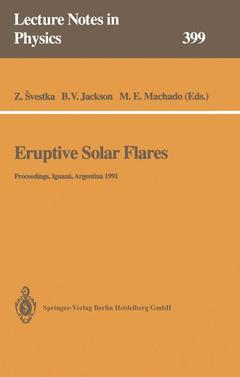Description
Eruptive Solar Flares, Softcover reprint of the original 1st ed. 1992
Proceedings of Colloquium No. 133 of the International Astronomical Union Held at Iguazú, Argentina, 2-6 August 1991
Lecture Notes in Physics Series, Vol. 399
Coordinators: Svestka Zdenek, Jackson Bernard V., Machado Marcos E.
Language: English
Subject for Eruptive Solar Flares:
Keywords
Solar flare; Variation; X-ray; chromosphere; energy; planet; solar; transport
Publication date: 11-2013
409 p. · 17x24.4 cm · Paperback
409 p. · 17x24.4 cm · Paperback
Description
/li>Contents
/li>
This is an exhaustive survey of present-day solar research including both theory and observations. It deals with eruptive flares, filament eruption in x-rays and radio waves, energy release and transport, and terrestrial response to solar flares. Details of the most recent SOLAR-A project (launched shortly after the conference) are also presented.
History and basic characteristics of eruptive flares.- Basic magnetic configuration and energy supply processes for an interacting flux model of eruptive solar flares.- The role of cancelling magnetic fields in the buildup to erupting filaments and flares.- Variation of the vector magnetic field in an eruptive flare.- Intrinsically hot flares and a possible connection to deep convective magnetic fields.- Interaction of large-scale magnetic structures in solar flares.- The intrinsic relationship between flares and eruption of filament currents.- Filament eruptions, flaring arches and eruptive flares.- MHD non-equilibrium: A numerical experiment.- Triggering of eruptive flares: Destabilization of the preflare magnetic field configuration.- Field opening and reconnection.- Energy release at Alfvénic fronts in a force-free magnetic flux tube.- Energy transport in solar flares: Implications for Ca XIX emission.- Fluid flow in a jet and the CA XIX line profiles observed during solar flares.- Characteristics of the impulsive phase of flares.- Comparison of UV and X-ray solar flare observations and theoretical models.- White-light flares.- “Post” flare loops.- Plasma parameters derived from MSDP observations of cool flare loops.- Flare evolution in the density temperature diagram.- The Neupert Effect: What can i tell us about the impulsive and gradual phases of eruptive flares?.- Particle acceleration in the impulsive phase of solar flares.- Kinetic description of electron beams in the chromosphere.- Nuclear reactions in flares.- Radio emission of eruptive flares.- Arcsecond determination of solar burst centers of emission simultaneous to high time resolution and high sensitivity at 48 GHz.- Trapping and escape of the high energy particles responsible for major proton events.- Coronal and interplanetary transport of solar flare protons from the ground level event of 29 september 1989.- High energetic solar proton flares of 19 to 29 October 1989.- Large-scale quasi-stationary X-ray coronal structures associated with eruptive solar flares.- Large scale structures associated with eruptive flares and radio waves.- Coronal millimeter sources associated with eruptive flares.- On the association between large scale X-ray brightenings and solar flares.- A giant post-flare coronal arch observed by Skylab.- Characteristics of coronal mass ejections.- The solar sources of coronal mass ejections.- Remote sensing observations of mass ejections and shocks in interplanetary space.- In situ observations of coronal mass ejections in interplanetary space.- Meter-decameter radio emission associated with a coronal mass ejection.- Models of normal and inverse polarity filament eruptions and coronal mass ejections.- MHD shocks and simple waves in CMES.- Terrestrial response to eruptive solar flares: Geomagnetic storms.- Stellar flares: Confined or eruptive events?.- Radio flare emission from late-type stars.- The Solar-A mission experiments and the targets.- Nobeyama radioheliograph.- Decimeter high resolution solar radio spectroscope.- Considerations of a Solar Mass Ejection Imager in a low-earth orbit.- An Observational-conceptual model of the formation of filaments.- Dynamics in the prominence-corona transition region from HRTS spectra.- Active region classifications, complexity, and flare rates.- Compact sources of suprathermal microwave emission detected in quiescent active regions during lunar occulatations.- Velocity field in the 13 June 1980 flare area.- Deformation of magnetic null points.- The X12 limb flare and spray of 01 June 1991.- Analysis of X-ray flares observed by the SMM spacecraft.- Distribution function for electron beams in the chromosphere.- Sub-second variations of HXR and H-alpha flare emission.- The role of protons in solar flares.- High spectral resolution of MM-wavelength (23 – 18 GHz) solar bursts.- Microwave flare characteristics in 8 and 3 mm Metsähovi measurements compared with optical and H-alpha data.- Simultaneous H? and microwave observations of a limb flare on June 20, 1989.- Nonresonant ion-beam turbulence in solar flares.- Nonlinear emission mechanism of type III solar radio bursts.- A numerical simulation of magnetically driven coronal mass ejections.- Coronal mass ejections: The link between solar and geomagnetic activity.- A study of geomagnetic variations with periods of four years, six months and 27 days.- Atmospheric models of flare stars.- The emerging picture of eruptive solar flares.
© 2024 LAVOISIER S.A.S.




